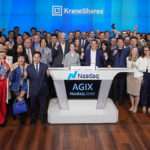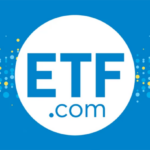KraneShares 2014 Year In Review and A Look Towards 2015

Brendan Ahern
Chief Investment Officer
We hope you and your family had a great holiday season. We have much to be thankful for both personally and professionally. With small children in my home, there is an infectious happiness and joy this time of year. I wanted to pause and reflect on 2014 while looking ahead to 2015. We maintain our commitment to providing financial professional insights and products to help take advantage of China’s continued economic growth and opening of the China Mainland equity and fixed income markets. What did we focus on in 2014?
- Operational excellence is job one. KraneShares Exchange Traded Funds (ETFs) are made possible through our partners SEI, Brown Brothers Harriman, and PriceWaterhouse Coopers to help ensure we provide world-class services for our shareholders. Investments into our ETFs require assets crossing multiple time zones and countries. Having implemented these procedures innumerable times over the last year we are confident in their effectiveness. Investors placed orders for our products through the following Authorized Participants (APs): Bank of America Merrill Lynch, Citigroup, Goldman Sachs, KCG, and Nomura, to name a few. Our lead market makers, Cantor Fitzgerald, KCG and Jane Street, have proven to be great partners. We believe that new APs such as BNP, Deutsche Bank, Societe Generale and Macquarie show that KraneShares is becoming a global brand. ConvergEx, BTIG, WallachBeth and StreetOne have helped us reach many different investor types. We are thankful to all of our partners. I am personally grateful and humbled to have such an incredible and talented team supporting our efforts.
- We created the KraneShares CSI China Internet ETF (ticker KWEB) to provide access to the rise of domestic consumption as China government policy looks to reorient the economy away from export dependency and fixed asset investment. We also believed that Alibaba might have an initial public offering and included a fast track inclusion into KWEB so we wouldn’t wait for our semi-annual rebalance to include the company. KWEB had its one year anniversary on August 1st 2014 as Alibaba began its IPO roadshow. Alibaba became the largest IPO ever in the United States raising awareness of this dynamic sector and a highly innovative company1. KWEB was the first China ETF and technology ETF in the world to hold Alibaba and remains one of a small number of ETFs and index mutual funds to own the company2. We bought Alibaba in the mid $80s range which we believe was a great entry point. We feel that our unique methodology of including both Hong Kong and US listed Chinese companies (rather than Hong Kong listed only) can potentially benefit our shareholders.
- We were able to gain unique access to China’s onshore equity market in order to list the KraneShares Bosera MSCI China A ETF (ticker KBA). We believed that onshore equities offered a compelling investment opportunity based on inexpensive valuations and the potential inclusion of the China A share market by index providers in the future. KBA’s launch was timely as the onshore markets rallied strongly beginning in June. I’ve always believed under owned and unloved are two great contrarian indicators. Onshore China equities today make up less than 0.05% of the US ETF market’s $2 trillion in AUM.3
- We built KraneShares with the belief that investors need growth, income and non-correlated assets. While China’s capital markets are not the only solution, we believe China’s market can help solve these issues. While KWEB provides exposure to growth companies and KBA to the non-correlated onshore equity market, we recently listed the KraneShares E Fund China Commercial Paper ETF (ticker KCNY) to help with investors’ income needs. The current low interest rate environment in the United States has forced investors to either take long duration/maturity risk or low quality investments in order to generate income.4 KCNY provides access to China’s onshore fixed income market with limited duration and investment-grade credit quality of underlying securities5 We are very appreciative of Cantor Fitzgerald, KCNY’s lead market maker, for their support in helping us during the listing process.
- We have a singular focus on educating investors on events in China. From Alibaba’s IPO to the Shanghai-Hong Kong Stock Connect, a program that allows investors to trade shares across the two markets using local brokers and clearing houses. we have endeavored to be the leading information source for investors on China. We will continue our efforts in 2015 to prove our commitment to assisting investors in understanding and learning about China’s economy and capital markets.
What lies ahead in 2015. We believe President Xi will become one of the most important leaders in China’s history. His commitment to reforming the economy and addressing the needs of China’s growing middle class will continue in the year ahead. These priorities include the environment, healthcare, growing domestic consumption and reforming State Owned Enterprises. MSCI will also announce if the onshore equities represented by KBA’s index will be included in their broader indices in the spring.
While there are a multitude of people who made 2014 a transformative year for KraneShares, I need to thank Josh Brown and Michael Batnick of Ritholtz Wealth for their support. I am deeply grateful for Josh and Mike’s willingness to hear our story and subsequent support. Steve Sjudgarten of Daily Wealth also spent time with us and became intrigued in our story. I would like to thank my partners and colleagues for their incredible work ethic as they inspire me on a daily basis. The hard work and effort of our Chinese partners, Bosera Asset Management and E Fund Asset Management, in making KBA and KCNY available to investors should not be overlooked. They have been consummate professionals in every aspect of our partnership. Lastly, I want to thank you our investors for your support. I remain dedicated to providing you differentiated and intuitive products based on China’s continued economic rise and evolution. Please do not hesitate to reach out anytime.
Sincerely,
Brendan Ahern
(646) 218-9852
[email protected]
Sources:
1.) Bloomberg article titled “Alibaba’s Bank Boost IPO Size to Record of $25 Billion” on September 22, 2014
2.) ETF Trends article titled “Talk Still Swirling About Alibaba’s Index Opportunities” on November 19, 2014
3.) ETF Trends article titled “US ETF Assets Hit $2 Trillion Milestone” on December 23, 2014. KraneShares calculates the aggregate assets of US listed onshore China ETF is approximately $1.02 billion. $1.02 billion divided by $2 trillion equals 0.05%.
4.) According to Investing Answers, duration is a measure of a bond's sensitivity to interest rate changes. The higher the bond's duration, the greater its sensitivity to the change (also known as volatility) and vice versa.
5.) For purposes of the Underlying Index, investment grade commercial paper is commercial paper that is issued by an issuer whose long-term bonds are rated AAA or equivalent by one or more Chinese credit rating agencies; or commercial paper that is issued by an issuer whose long-term bonds are rated AA+ or equivalent by one or more Chinese credit rating agencies and commercial paper is rated A-1 or equivalent by one or more Chinese credit rating agencies
Both KWEB and KFYP invest in variable-interest entities (VIEs), which are investments in foreign-domiciled American Depository Receipts (ADRs). Rather than owning Chinese-domiciled entities, the VIEs have contractual arrangements designed to provide the economic benefits related to certain Chinese-domiciled companies. The structure of VIEs presents some unique risks that should be considered.
VIE structures do not give investors ownership in the operating company, as stock does. With a VIE, an investor has no direct claim on the core, restricted business assets of the VIE operating company. As a result, investors may not exert as much influence over the subject company as they could if they were owners of common stock. Often, the voting rights in the VIE operating company, especially in matters of corporate governance, are controlled by the principals who established the VIE operating company.
In addition, there is no guarantee as to the enforceability of the VIE structure, as it has never received explicit approval from the Chinese government and is recognized as a structure put in place principally to work around Chinese restrictions on foreign investment.













